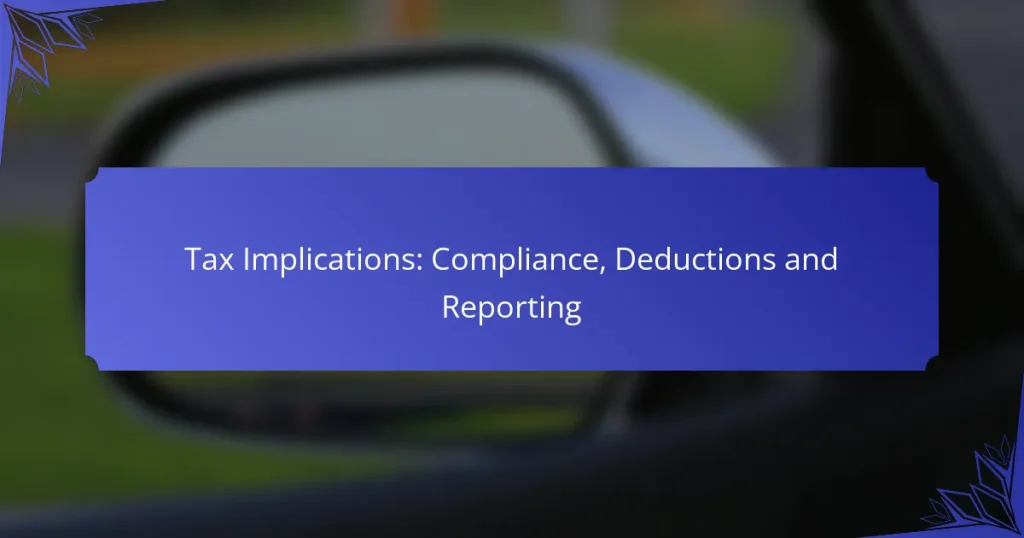Understanding tax implications is essential for both individuals and businesses to ensure compliance and optimize financial outcomes. Key requirements include timely filing of returns, accurate income reporting, and maintaining proper records. By recognizing the nuances of deductions and reporting obligations, taxpayers can navigate the complexities of the tax system and potentially achieve significant savings.

What Are the Key Tax Compliance Requirements in the US?
Key tax compliance requirements in the US include timely filing of tax returns, accurate reporting of income and deductions, and adherence to record-keeping standards. Meeting these obligations helps individuals and businesses avoid penalties and ensures proper tax administration.
Filing deadlines
Filing deadlines are crucial for compliance. For individual taxpayers, the standard deadline is April 15 for the previous tax year, while businesses may have different deadlines based on their structure. Extensions may be available, but they do not extend the payment deadline.
For example, if April 15 falls on a weekend or holiday, the deadline shifts to the next business day. It’s essential to mark these dates on your calendar to avoid late fees.
Required forms
Different types of taxpayers must use specific forms to report their income and deductions. Individuals typically file Form 1040, while corporations may use Form 1120. Each form has its own set of schedules that may need to be completed based on the taxpayer’s situation.
It is important to ensure that you are using the correct forms for your tax situation, as using the wrong form can lead to delays and potential penalties. The IRS website provides up-to-date information on required forms and instructions for completion.
Record-keeping obligations
Record-keeping is essential for substantiating income and deductions claimed on tax returns. Taxpayers should retain records such as receipts, invoices, and bank statements for at least three years from the date of filing. This period can extend if you fail to report income or if you file a claim for a loss.
Organizing records can simplify the filing process and provide necessary documentation in case of an audit. Consider using digital tools to keep track of your financial documents, ensuring they are easily accessible when needed.

How to Maximize Deductions for Individuals?
To maximize deductions, individuals should understand the difference between standard and itemized deductions, identify common deductible expenses, and recognize the distinction between tax credits and deductions. This knowledge can lead to significant tax savings and better financial planning.
Standard vs. itemized deductions
The standard deduction is a fixed dollar amount that reduces your taxable income, while itemized deductions allow you to list specific expenses to lower your tax bill. For the tax year 2023, the standard deduction is approximately $13,850 for single filers and $27,700 for married couples filing jointly in the U.S.
Choosing between standard and itemized deductions depends on which option provides a greater tax benefit. If your total itemized deductions exceed the standard deduction, it may be advantageous to itemize. Keep track of eligible expenses such as mortgage interest, property taxes, and charitable contributions.
Common deductible expenses
Common deductible expenses include mortgage interest, medical expenses exceeding a certain percentage of your adjusted gross income, and state and local taxes. Additionally, educational expenses, certain unreimbursed business costs, and contributions to retirement accounts can also qualify.
To ensure you maximize your deductions, maintain organized records of all expenses throughout the year. This practice not only helps you claim all eligible deductions but also simplifies the tax filing process.
Tax credits vs. deductions
Tax credits directly reduce the amount of tax owed, while deductions lower your taxable income. For instance, a $1,000 tax credit reduces your tax bill by $1,000, whereas a $1,000 deduction might save you a fraction of that amount, depending on your tax rate.
Understanding this difference is crucial for tax planning. Focus on maximizing tax credits, as they often provide more significant savings than deductions. Be aware of available credits, such as the Earned Income Tax Credit or Child Tax Credit, which can significantly impact your tax liability.

What Are the Reporting Obligations for Businesses?
Businesses must adhere to specific reporting obligations to remain compliant with tax regulations. These obligations include making quarterly estimated tax payments, filing annual tax returns, and reporting payments made to independent contractors using Form 1099.
Quarterly estimated tax payments
Quarterly estimated tax payments are required for businesses that expect to owe a certain amount in taxes for the year, typically over a few hundred dollars. These payments are usually due in April, June, September, and January of the following year.
To calculate these payments, businesses can use the previous year’s tax liability or estimate their current year’s income. It’s crucial to avoid underpayment penalties by ensuring that payments meet at least 90% of the current year’s tax or 100% of the previous year’s tax, whichever is lower.
Annual tax return requirements
All businesses must file an annual tax return, which summarizes their income, expenses, and tax liability for the year. The specific form used depends on the business structure, such as Schedule C for sole proprietors or Form 1120 for corporations.
Filing deadlines vary; for instance, most corporations must file by the 15th day of the fourth month after the end of their fiscal year. Businesses should keep accurate records throughout the year to facilitate this process and ensure compliance with tax laws.
Form 1099 reporting
Form 1099 is used to report payments made to independent contractors and other non-employees. Businesses must issue a 1099 form if they pay an individual or entity $600 or more in a calendar year for services rendered.
These forms must be sent to the recipients by January 31 of the following year and filed with the IRS by the end of February if submitted on paper or by March 31 if filed electronically. Keeping track of payments throughout the year can simplify this reporting process and help avoid penalties for late filing.

How to Choose a Tax Professional?
Selecting a tax professional is crucial for ensuring compliance and maximizing deductions. Consider their qualifications, fee structures, and specializations to find the right fit for your needs.
Qualifications to look for
When choosing a tax professional, verify their qualifications such as certifications and licenses. Look for credentials like Certified Public Accountant (CPA), Enrolled Agent (EA), or tax attorney, as these indicate a higher level of expertise.
Additionally, check their experience in handling tax situations similar to yours. A professional with a solid track record in your specific financial circumstances can provide more tailored advice.
Fee structures
Tax professionals may charge fees in various ways, including hourly rates, flat fees, or a percentage of your refund. Hourly rates can range from $100 to $400, while flat fees for standard tax preparation might be between $200 and $1,000, depending on complexity.
Before hiring, ask for a clear breakdown of their fee structure and any potential additional costs. Understanding how they charge can help you avoid unexpected expenses.
Specializations in tax law
Different tax professionals may specialize in areas such as individual tax returns, corporate taxes, or estate planning. If you have specific needs, such as owning a business or dealing with international tax issues, seek a professional with expertise in those areas.
Additionally, consider their familiarity with the latest tax laws and regulations, which can significantly impact your tax strategy. A specialist can help you navigate complex tax scenarios effectively.

What Are the Consequences of Non-Compliance?
Non-compliance with tax regulations can lead to significant repercussions, including financial penalties, increased scrutiny from tax authorities, and potential damage to your credit score. Understanding these consequences is crucial for maintaining compliance and avoiding costly mistakes.
Penalties and fines
Tax authorities impose penalties and fines on individuals and businesses that fail to comply with tax laws. These penalties can vary widely, often ranging from a percentage of the unpaid tax amount to fixed fees, depending on the severity of the non-compliance. For example, late filing penalties may start at 5% of the unpaid tax per month, up to a maximum of 25%.
In some cases, willful neglect or fraud can lead to even steeper fines or criminal charges. It is essential to file taxes accurately and on time to avoid these financial repercussions.
Audit risks
Non-compliance increases the likelihood of being audited by tax authorities. Audits can be time-consuming and stressful, often requiring extensive documentation and explanations of your financial activities. Factors that may trigger an audit include discrepancies in reported income, excessive deductions, or failure to report foreign assets.
To minimize audit risks, maintain thorough records of all financial transactions and ensure that your tax returns are accurate and complete. Consulting with a tax professional can also help identify potential red flags before filing.
Impact on credit score
Non-compliance with tax obligations can negatively affect your credit score. Tax liens, which are legal claims against your property due to unpaid taxes, can be reported to credit bureaus and remain on your credit report for several years. This can hinder your ability to secure loans or favorable interest rates.
To protect your credit score, prioritize timely tax payments and resolve any outstanding tax issues as soon as possible. Regularly monitoring your credit report can help you catch any negative impacts early and take corrective action.

How Do State Taxes Differ from Federal Taxes?
State taxes vary significantly from federal taxes in terms of rates, types, and regulations. While federal taxes are uniform across the country, state taxes can differ widely, affecting income, sales, and property tax obligations.
State-specific deductions
State-specific deductions can reduce taxable income at the state level, varying by jurisdiction. These deductions may include expenses such as state taxes paid, mortgage interest, and certain medical expenses, which can differ from federal deductions.
For example, some states allow a deduction for property taxes paid, while others do not. Taxpayers should review their state’s tax code to identify available deductions and ensure they are maximizing their tax benefits.
Additionally, certain states offer unique deductions for specific industries or professions, such as educators or healthcare workers. It is essential to stay informed about these opportunities to optimize tax savings.


